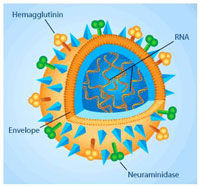ISTN receives NIH Nanotechnology Grant for the development of an Immobilized Enzyme Technology
ISTN recieved the award of a $173,000 Phase I Small Business Innovation Research (SBIR) grant from the National Institutes of Health (NIH). The grant is part of NIH's Bioengineering Nanotechnology Initiative, a special SBIR program for "nanotechnologies useful to biomedicine." This award will support the development of a nanocomposite device that will enable immobilized enzymes to aid in the production and separation of various chemical compounds.
The initial studies will be aimed at producing chiral specific drug intermediates targeted toward the pharmaceutical industry. Clinical studies have clearly demonstrated the superior value of chiral drugs. A majority of clinical results have shown that only one enantiomer of a drug provides the desired activity while the counterparts are inactive or, even toxic. Among the world's current top ten selling drugs (such as Lipitor, Zocor, etc.), nine active ingredients are chiral. At present, over half of the chiral products are made by traditional methods (pool and separation), one third are produced by chemocatalysis, and only about 15% are derived from biocatalysis. However, the trend is changing in favor of biocatalysis due to the tremendous progresses in biomedicines, including high throughput screening, modern molecular biology techniques such as directed evolution as well as surges in the fields of genomics and bioinformatics.
In addition to the pharmaceutical industry ISTN has identified a number of other large markets that would benefit from development of this novel chemical synthesis method. The nearly $50 billion LCD market is expected to be one of the largest consumers of fine chemicals in the years ahead and a technology to more efficiently produce many of these compounds could see a large commercial reward. In addition, enzymatic synthesis and separation is expected to play a large role in the food and beverage industries as traditional production methods are replaced.
Most read news
Topics
Organizations
Other news from the department research and development

Get the analytics and lab tech industry in your inbox
By submitting this form you agree that LUMITOS AG will send you the newsletter(s) selected above by email. Your data will not be passed on to third parties. Your data will be stored and processed in accordance with our data protection regulations. LUMITOS may contact you by email for the purpose of advertising or market and opinion surveys. You can revoke your consent at any time without giving reasons to LUMITOS AG, Ernst-Augustin-Str. 2, 12489 Berlin, Germany or by e-mail at revoke@lumitos.com with effect for the future. In addition, each email contains a link to unsubscribe from the corresponding newsletter.






























































